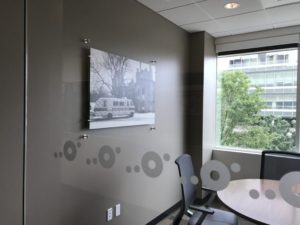Let There Be Light!
September 29, 2017
The Value of Lighting in Interior Design
 Light is a powerful thing that is fundamentally positive. It enhances, identifies, and shows the way. It is no wonder that it is one of the most popularly used cultural idioms; to shed light on, come to light, seen the light, and the list goes on.
Light is a powerful thing that is fundamentally positive. It enhances, identifies, and shows the way. It is no wonder that it is one of the most popularly used cultural idioms; to shed light on, come to light, seen the light, and the list goes on.
Light, both natural and artificial, is also valuable in designing interiors. “Lighting creates interest in a space, adds comfort, warmth and safety,” says Les McCoy, President of DesignPoint, Inc. of Bethlehem, PA. “Regardless of the project and the use of the space, the principles of light are universal in properly designing interiors.”
Performance
Every interior space has an intended function, whether to encourage work, interaction, engagement or feelings. Too much light can be blinding, and not enough light is paralyzing; find the right balance.
Safety
Poor illumination is the cause of many accidents. Safety is paramount to all real estate owners, but it is of specific importance in health care and senior living when dealing with deteriorating eyesight and other health conditions in patients. A good interior designer takes into consideration what the interior looks like during the day time as well as how it feels and performs after the sun goes down.
Interest
Shining a light on a painting in an office reception area or above a door in a senior living community creates warmth and attracts attention. A senior living resident will feel safer and proud of their personal suite if they have a well-lit entrance. Hotels are doing this in order to make each customer feel welcomed in their room. Balanced lighting encourages focus on a person or thing, whether it is a meeting, work station or patient.
Emotions
Light sets the mood. Darkness, or a lack of light, feels mysterious, cold, dangerous or unsettling. Too much light can be distracting and over—stimulating. A good interior designer can get inside the head of the user of the space to understand how they should feel, and create the area to support those emotions.
Natural Light vs. Artificial Light
Recently, architectural and design trends have called for abundant natural light to bring the outside in. This is achieved in numerous ways. Options have increased as technology has improved construction materials like glass products for light tubes and skylights and interior products window coverings like solar shades and automated blinds. Interior designers have a plethora of options at their fingertips to promote and support the goal and use of interior space.
Natural Light
Scientific research has proven that people subconsciously seek out sunlit places and enjoy spending time in natural light. Research has also proven that there are real benefits associated with spending time in spaces that offer abundant natural light. The benefits of natural lighting are numerous and can affect a person’s health, the environment and energy usage.
Bringing natural light in is important but sometimes can be challenging. “Many clients desire ample sunlight in their office, hotel and senior living rooms,” says McCoy. “For spaces and rooms on the building’s perimeter this is easily accomplished with windows, skylights and light tubes. For interior areas without access to an external wall, reconfiguration is necessary to remove walls and re-arrange spaces to allow for openness and glass walls for light to penetrate. It is more complicated, but it can be done with a good interior designer.”
Artificial Light
Natural light is not always everyone’s friend. For those trying to sleep or rest, watch a movie in a theatre or focus on working at their computer natural light may be unwanted. Making light available can also be cost prohibitive.
Fortunately, with the evolution in lighting technology like LED (light omitting diode) lights, artificial light can be more abundant, more friendly and more economical. LED allows for a more enhanced color feel than fluorescent light. Newer lighting solutions, like RGB (red green blue) LED lights allow for lights to change color to influence moods. This is valuable in many settings from memory care to entertainment venues.
Most people want ample light in their interior spaces as well as a way to control the light. “There are many material options, construction solutions, and lighting products out there, the trick is to know what exists and which have the best practical application for the project,” explains McCoy.
If you would like the team at DesignPoint to shed some light on your interior spaces, then contact them at 610-807-9670
DesignPoint is located in Bethlehem, Pennsylvania and works extensively on both a regional and national level. DesignPoint, Inc. is a full service Interior Design & Purchasing Firm with a focus on corporate, hospitality, senior living, medical offices and high-end residential interiors. When considering new interior construction or renovations, DesignPoint will provide complete interior architectural space planning, construction documents, and furniture, fixtures and equipment (FF&E) procurement services to make it a successful project. DesignPoint is located in Bethlehem, PA and can be reached at 610-807-9670 or online at info@designpoint-interiors.com.